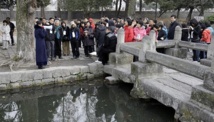Historic N. Korea city wins World Heritage status
AFP
PHNOM PENH- Royal tombs, fortress walls and a 700-year-old school in North Korea's medieval city of Kaesong were among a dozen monuments granted World Heritage status by UNESCO at its annual meet on Sunday.
Twelve sites in the city, the heart of the Koryo dynasty which unified the Korean peninsula for the first time, were classified on the grounds of embodying "the political, cultural, philosophical and spiritual values" of the kingdom, UNESCO said.

They are located several kilometres from an industrial park jointly run by the divided North and South which has been closed since April after tensions between the bitter enemies reached boiling point.
Hailing Kaesong's "outstanding universal value" UNESCO said the monuments "are exceptional testimony to the unified Koryo civilization as Buddhism gave way to neo-Confucianism in East Asia".
As the decision was announced several black-suited North Korean delegates at the United Nations Educational, Scientific and Cultural Organization committee annual session in Phnom Penh, stood and clapped.
Thanking UNESCO for the listing one of the North Koreans hailed the "joyful occasion" in a brief statement to the auditorium.
Kaesong was established in 919 as the capital of the Goryeo dynasty (918-1392) -- also known as Koryo -- which gave its name to the modern state of Korea.
The dynasty is credited with creating a unified national identity for the first time.
When the Korean peninsula was partitioned along the 38th parallel after World War II, Kaesong was in South Korea.
During the 1950-53 Korean War, it came under North Korean control and remained so until the end of the conflict, thus becoming the only city to change from South to North control as a result of the war.
UNESCO has this week granted World Heritage status to more than a dozen natural wonders and cultural jewels, including two iconic volcanos -- Japan's Mount Fuji, known for its perfectly cone-shaped volcano, and Italy's Mount Etna -- as well as the Hill Forts of Rajasthan and the Namib Sand Sea.
It was expected later Sunday to give heritage status to twelve villas that once belonged to the famous renaissance-era Medici family in Tuscany and reach a decision over ancient ruins in Ukraine.
------------------------------------------------------------------------------------------------